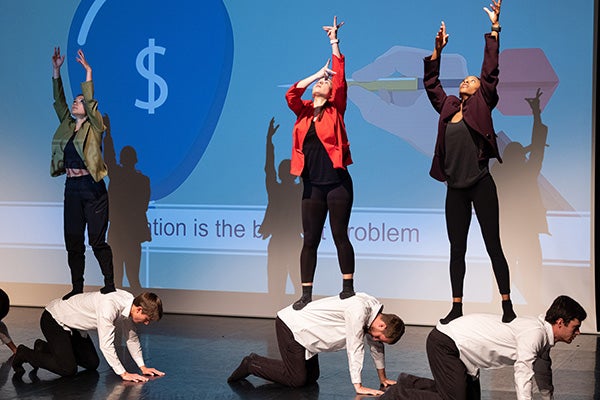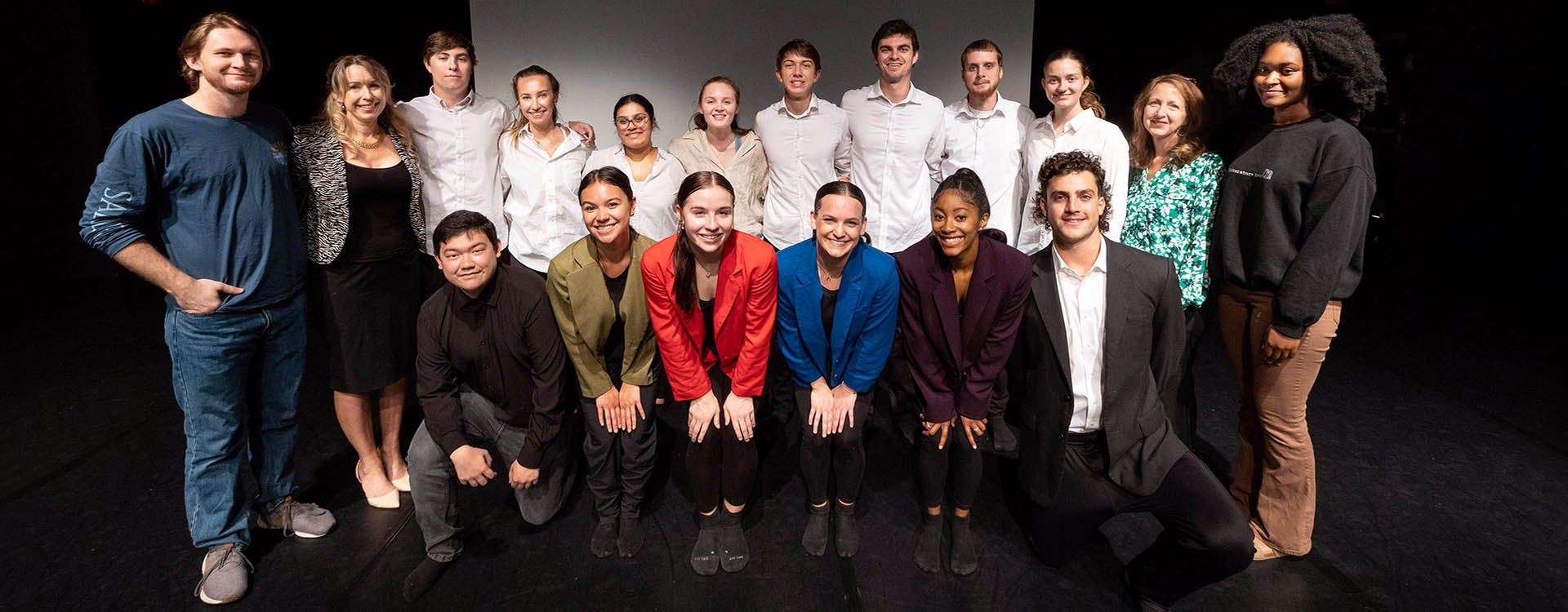ECU dance, macroeconomics students collaborate on class finale
The last week of classes at East Carolina University brought students in macroeconomics and dance together for a performance illustrating the highs and lows of the U.S. economy.
The students collaborated on “Unraveling Economic Cycles,” performed April 26 in the Archie Burnette Studio Theatre in Messick Theatre Arts Center. Using a mix of commentary and dance movements, the students defined a normal economy contrasted with the effects of the Great Recession of 2008 and the pandemic.
“While this might seem like a class exercise, it is about how we move in the world, how we work and buy things,” said economics student Tyler Gelnett.

Dance and economics students act out economic principals. (ECU photos by Rhett Butler)
From running in circles to crouching and falling on the floor, students demonstrated economic principals such as recession, inflation, unemployment and growth. They discussed how markets self-correct and other times when federal officials must act.
“If there is a slowdown, we want the economy to grow, so we’d increase government spending on things like education and national defense,” said economics student Morgan Davis. “Another option would be to decrease taxes so that households could spend more. The problem with spending more and taxing less is that the government’s budget will be in deficit and accumulate into debt.”
So why should consumers care? “Slow growth means that households have less income and can buy less stuff. Unemployment increases, meaning it’s harder to find a job. If we have inflation, the money we have doesn’t buy as much,” Gelnett said. At 6%, the current inflation rate is three times higher than the normal rate.
“‘Normal’ is a target, a goal,” Davis said. “It helps us compare where we are to where we want to be. The difference helps us know what to expect will happen next.”
Samantha Halik, a senior dance major from Wake Forest, said she enjoyed moving through the narrating of the pre- and post-pandemic economy. “Knowing that our dancing and dance in college came to a halt and everything stopped, and we were learning off iPads and doing Zoom dance classes, it just made me think about how dancers experiencing the economy fall, then having to perform it,” she said.
The students practiced about five hours over two weeks to prepare for the finale, gaining a deeper appreciation of each discipline.
Greater appreciation
Cooper Hilbert, a freshman from Wilmington who is majoring in economics as well as community and regional planning, said he came away with a better understanding of the performing arts at ECU. “Seeing the dancers’ routines, learning the movements, seeing how they practice… it’s just a unique experience that I’ve never had before,” he said.
His only performing experience previously came in middle school, when he worked behind the scenes on sound for a production of “Legally Blonde.” He later took a theater appreciation class. He said acting out the parts helped him to remember key concepts in this original economic dance show.
“When you have to learn it and memorize it, it makes it so much easier because you can associate each of these concepts with a different part of the show,” Hilbert said. “You have the housing part, you have the COVID part, you have dealing with inflation, economic booms, economic busts.”
Meghan Millea, professor of economics, and Jayme Host, director of the School of Theatre and Dance, collaborated on the project. “One of the things I really enjoy at ECU is being able to find these cross-disciplinary connections and to be able to integrate our knowledge and our experiences to one holistically human experience,” Host said.
Millea had experience writing a grant and developing an arts integration project at another university before joining ECU. “I was just blown away by how much fun it was, how the students reacted to it,” she said.
While these types of projects are more commonly done in K-12 schools, Host said there are multiple learning patterns and pathways to students that doesn’t end at 12th grade. The performance is a model for how it can work at the university level.
The entire 10-member economics class was all in, Millea said. “They said, ‘Let’s do it.’ They came over and met with Jayme in the studio and after that, they just started seeing the connections,” she said. The students are Sara Beaman, Ethan Collins, Davis, Emma Gebel, Gelnett, Alex Hanff, Hilbert, Archie Kalaf, Shweta Kumar and Bruce Sotelo.
The dance students are Kyleigh Burton, Haley DiGirolamo, Halik and Gabby Hill. Grace Gardner coordinated technical production, running lights and projections, and Bradley Peacock filmed the project.

Macroeconomics and dance students collaborated on a performance illustrating the highs and lows of the economy.